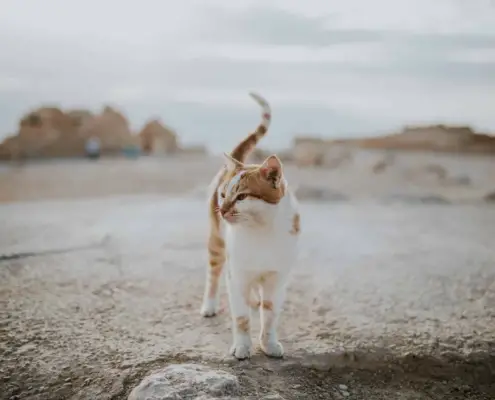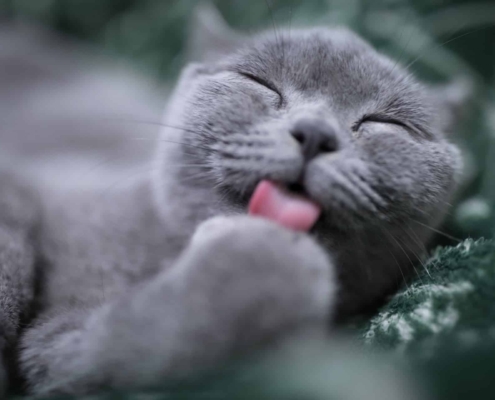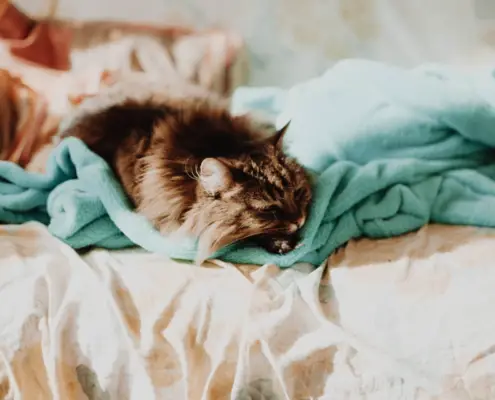
Feline Leukemia Virus (FeLV) is a viral infection that affects cats worldwide. It is one of the most common and serious infectious diseases in cats, causing a wide range of health problems and potentially leading to a shortened lifespan. FeLV attacks the immune system, making cats more susceptible to infections, cancers, and other diseases.
FeLV is highly contagious and can be transmitted through close contact with an infected cat. Kittens are particularly vulnerable to the virus as their immune systems are not fully developed. It is important to understand the causes, transmission, symptoms, diagnosis, and treatment options for FeLV to protect your feline friends.
How is feline leukemia virus transmitted?
FeLV is primarily transmitted through saliva, urine, feces, and nasal secretions of infected cats. The most common modes of transmission include direct contact, such as grooming, sharing food and water bowls, and mating. It can also be transmitted from an infected mother cat to her kittens during pregnancy, birth, or through nursing.
Outdoor cats are at a higher risk of contracting FeLV as they have more opportunities for exposure to infected cats. Cats that live in multi-cat households and those that have access to communal areas, such as shelters or catteries, are also more susceptible to the virus. Sharing litter boxes and close social interactions can facilitate the spread of FeLV among cats.
Symptoms and signs of feline leukemia virus in cats
The symptoms of FeLV can vary depending on the stage of the infection and the cat’s immune response. Some cats may not show any symptoms initially, while others may exhibit a range of signs such as:
- Lethargy and weakness: Cats infected with FeLV may become increasingly tired and lack energy.
- Poor appetite and weight loss: Infected cats may lose interest in food and experience significant weight loss.
- Fever and recurring infections: FeLV weakens the immune system, making cats more susceptible to infections, including respiratory and urinary tract infections.
- Anemia and pale gums: FeLV can cause a decrease in red blood cells, leading to anemia, which can be detected by pale gums.
- Swollen lymph nodes: Enlarged lymph nodes can be a sign of FeLV, particularly in the later stages of the disease.
- Tumors and cancers: FeLV increases the risk of developing various types of cancers, including lymphoma and leukemia.
It is important to note that these symptoms can also be associated with other diseases, so a proper diagnosis is essential to determine if FeLV is the cause.
Diagnosis and testing for feline leukemia virus
If you suspect that your cat may have been exposed to FeLV or is showing symptoms of the virus, it is crucial to consult a veterinarian for a proper diagnosis. The veterinarian will perform various tests to confirm the presence of FeLV, including:
- ELISA test: This is the most commonly used test to detect FeLV. It detects the presence of viral antigens in the cat’s blood. A positive ELISA test result indicates that the cat is infected with FeLV.
- IFA test: If the ELISA test comes back positive, an Immunofluorescent Antibody (IFA) test is usually conducted to confirm the diagnosis. This test is more sensitive and specific and can detect the virus at an early stage.
- PCR test: Polymerase Chain Reaction (PCR) test can be used to detect FeLV DNA in the cat’s blood. It is a highly accurate test and can be used to diagnose FeLV in cats with low levels of viral antigens.
It is important to note that kittens born to FeLV-positive mothers may test positive for the virus initially, but some may be able to clear the infection on their own as they mature. Repeat testing is recommended in these cases.
Treatment options for cats with feline leukemia virus
Unfortunately, there is no cure for FeLV. Treatment mainly focuses on managing the symptoms and secondary infections to improve the cat’s quality of life. Some of the treatment options include:
- Antiviral medications: Antiviral drugs may be prescribed to slow down the replication of the virus and reduce the severity of symptoms.
- Immune-supportive therapy: Boosting the cat’s immune system through supplements and medications can help in fighting off infections and improving overall health.
- Antibiotics: Cats with FeLV are prone to bacterial infections. Antibiotics may be prescribed to treat these infections and prevent further complications.
- Fluid therapy: FeLV-positive cats may require intravenous fluids to maintain hydration and support organ function.
- Regular veterinary check-ups: Regular monitoring of the cat’s health, including blood tests and screenings for secondary infections or cancers, is essential to catch any complications early.
It is important to work closely with a veterinarian to tailor the treatment plan to your cat’s specific needs.
Preventing feline leukemia virus in cats
Prevention is key when it comes to FeLV. Here are some measures you can take to protect your cats from the virus:
- Vaccination: Vaccination is the most effective way to prevent FeLV. Kittens should receive their initial vaccines as early as eight weeks of age, followed by booster shots. Adult cats should also be vaccinated if they are at risk of exposure.
- Keep cats indoors: Keeping cats indoors can significantly reduce their chances of coming into contact with infected cats and reducing the risk of FeLV transmission.
- Separate FeLV-positive cats: If you have multiple cats and one has tested positive for FeLV, it is important to separate them to prevent further spread of the virus.
- Regular veterinary check-ups: Regular visits to the veterinarian can help detect FeLV early and prevent the spread to other cats.
- Good hygiene practices: Regularly cleaning litter boxes, food and water bowls, and grooming equipment can help reduce the risk of FeLV transmission.
By following these preventive measures, you can greatly reduce the risk of your cats contracting FeLV.
Living with a cat diagnosed with feline leukemia virus
If your cat has been diagnosed with FeLV, it is essential to provide them with the best possible care and support. Here are some tips for living with a FeLV-positive cat:
- Create a stress-free environment: FeLV-positive cats may have compromised immune systems, making them more susceptible to stress-related illnesses. Provide a calm and comfortable environment to help boost their overall well-being.
- Balanced diet: Feed your cat a nutritionally balanced diet to support their immune system and overall health. Consult with your veterinarian for dietary recommendations.
- Regular veterinary check-ups: Regular veterinary visits are important to monitor your cat’s health and catch any complications early.
- Isolate FeLV-positive cats: If you have multiple cats, it is important to separate the FeLV-positive cat from the others to prevent the spread of the virus.
- Show them love and care: FeLV-positive cats still deserve love and attention. Spend quality time with them and provide them with mental stimulation and enrichment.
With proper care and support, FeLV-positive cats can live happy and fulfilling lives.
Feline leukemia virus vaccination and its effectiveness
Vaccination is the most effective way to prevent FeLV in cats. The FeLV vaccine stimulates the cat’s immune system to produce protective antibodies against the virus. It is recommended for all cats, especially those at risk of exposure, such as outdoor cats or those living in multi-cat households.
The FeLV vaccine is typically administered in a series of injections, starting at eight weeks of age. Booster shots are required to maintain immunity. It is important to follow the vaccination schedule recommended by your veterinarian.
While the FeLV vaccine is highly effective, it is not 100% foolproof. Some cats may still contract the virus despite being vaccinated. However, vaccinated cats typically have a better chance of fighting off the infection and experiencing milder symptoms.
Frequently asked questions about feline leukemia virus
- Can FeLV be transmitted to humans or other animals?FeLV is a feline-specific virus and cannot be transmitted to humans or other animals.
- Can FeLV-positive cats live with FeLV-negative cats?It is generally recommended to separate FeLV-positive cats from FeLV-negative cats to prevent transmission.
- Can FeLV-positive cats be treated and cured?While there is no cure for FeLV, supportive care and treatment can help manage symptoms and improve the cat’s quality of life.
- Is FeLV contagious during the incubation period?FeLV can be contagious during the incubation period, even if the infected cat is not showing any symptoms.
- Can FeLV-positive cats be vaccinated?Vaccination is not recommended for FeLV-positive cats, as they already have the virus and the vaccine will not provide any benefit.
Conclusion
Feline Leukemia Virus is a serious threat to the health and well-being of cats. Understanding the causes, transmission, symptoms, diagnosis, and treatment options for FeLV is crucial for cat owners to protect their feline companions. By following preventive measures, such as vaccination and good hygiene practices, and providing proper care and support for FeLV-positive cats, we can keep our cats safe from this devastating virus. Consult with a veterinarian for personalized advice and guidance in managing FeLV and safeguarding the health of your cats.
Protect your cats from Feline Leukemia Virus – Consult with a veterinarian today!
If you enjoyed my article, I would appreciate you sharing it with your network.

Sima Ndlebe
Sima writes for CatBuzz. He is interested in Cats, Health and Fitness, and Entrepreneurship.
Published: 12 October 2023
Related Articles
Disclaimer
The content found on CatBuzz.org is presented on an "as is" basis and is intended for general consumer information and education purposes only. Any utilization of this information is voluntary and solely at the user's own risk.
None of the articles or content should be regarded as, or used in place of, veterinary medical advice, diagnosis, or treatment. The information provided on the website is purely for educational and informational intentions and should not be considered a substitute for professional guidance from a veterinarian or other qualified expert. The articles are designed to inform consumers about veterinary healthcare and medical matters that may impact their cat's daily life. It should be noted that this website and its services do not constitute the practice of any form of veterinary medical advice, diagnosis, or treatment. CatBuzz.org explicitly disclaims any liability for any direct or indirect damages or losses that may arise from the use of or reliance on the information contained within the content.
Consumers must consult a veterinarian, veterinary specialist, or another qualified veterinary healthcare provider when seeking advice regarding their cat's health or medical conditions. It is important not to ignore, avoid, or postpone seeking medical advice from a veterinarian or other qualified veterinary healthcare provider solely based on information obtained from this website. If you believe that your cat may be experiencing a medical issue or condition, it is imperative to promptly contact a qualified veterinary healthcare professional.




